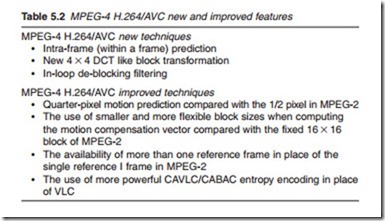The road to MPEG-4/H.264/AVC
In January 1988, MPEG gathered together some experts from the ISO/IEC in order to define a standard for the encoding of motion pictures. The standard was MPEG-1 for applications in the multimedia field and its successor MPEG-2 for broadcasting applications. MPEG-2 was success- fully implemented in SD digital video broadcasting (DVB), and DVD. The first successor to MPEG-2 was MPEG-4 published in 1999 taking an object-based approach to video compression. Conventional images became object planes and where an object intersects an object plane, it is described using intra-coding, forward projection and bi-directional pre- dictions. MPEG-4 also introduced wavelet coding to still objects. It was defined for a host of new applications in the low-bit multimedia field including inter-active mobile multimedia communications, videophone, mobile audio–visual communication, multimedia electronic mail, remote sensing, video conferencing, games and many others. In 2001, with the aim of developing a more efficient compression system, the standard- isation bodies ISO/IEC and ITU combined their efforts in a working group charged with developing a coding system which was to be known as advanced video coding (AVC) suitable for broadcasting high definition video. In 2003, the AVC system was established and integrated as part 10 of the MPEG-4 and assumed the name H.264. In 2004, AVC/H.264 was included as part of DVB transport system.
The AVC system is not compatible with MPEG-2 in that it does not produce a compliant bitstream and thus its introduction will require the use of new encoders and decoders.
MPEG-4 profiles
The H.264/AVC scheme includes a different set of profiles than MPEG-2 to support the extensive list of multimedia applications. The following is a summary of MPEG-4 profiles:
● baseline profile for low-delay end-to-end applications;
● extended profile for mobile application;
● main profile for broadcasting applications at SD at a bit rate of 1.5–2 Mbps;
● high profile for broadcasting at high definition as well as studio applications.
The high profiles has several sub-sections including 8-bit and 10-bit samples, 4:2:0, 4:2:2 and 4:4:4 sampling structures.
H. 4/AVC features
The MPEG-4 H.264/AVC standard represents the advanced evolution of familiar MPEG-2 technology. It was designed specifically for carriage over existing MPEG-2 transport and modulation infrastructures. The result is a standard that includes powerful data compression. The aim is to make it possible to produce SDTV quality pictures at a bit rate of 1.5–2 Mbps and HDTV at a bit rate of 6–10 Mbps. Its audio counter part is advanced audio coding (AAC) system which supports multi-channel and surround sound.
The higher compression efficiency is paid for in terms of increased complexity in both the encoder at the transmitting end and the decoder at the receiving end. The AVC encoder is about eight times more complex than that used in MPEG-2 requiring extremely fast and intensive computing processing power. Such processing powers are now available which made the use of AVC in HDTV broadcasting a commercial viability.
AVC does not support object-based coding. It is intended for use with entire pictures and as such it builds upon MPEG-2 adding some refinements to existing coding tools and introducing new compression techniques (Table 5.2).
